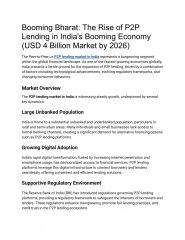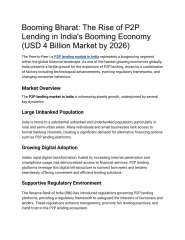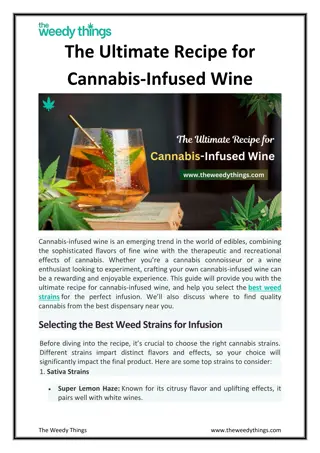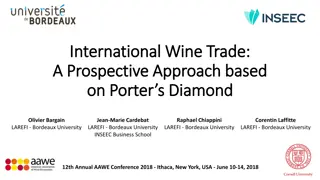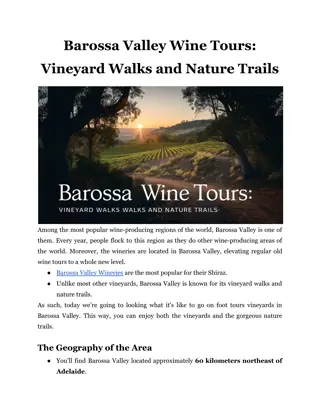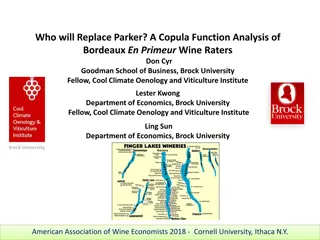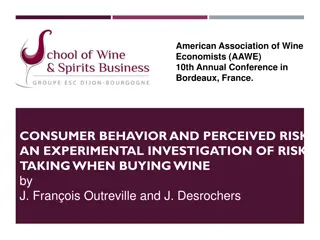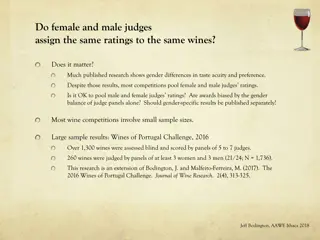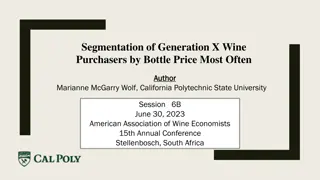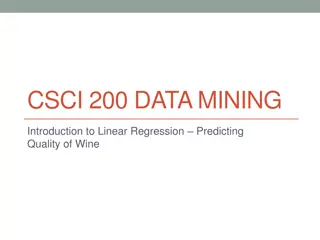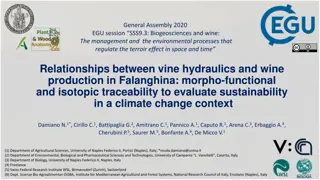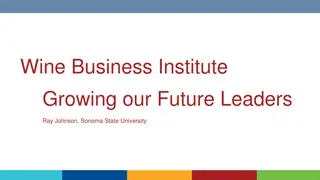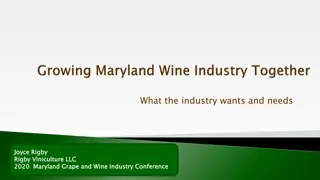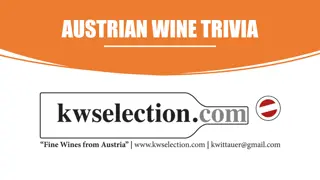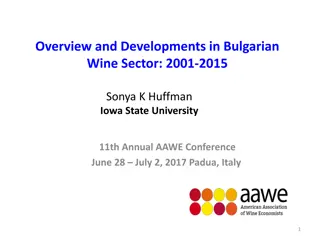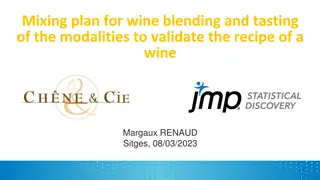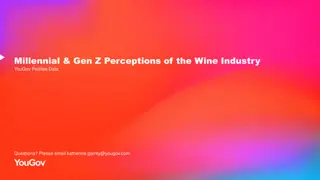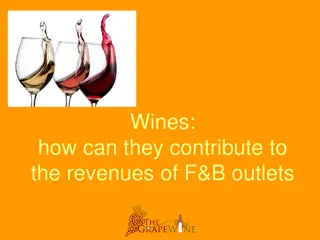Insights into the Booming Wine Industry and Future Trends
The wine industry in the US is flourishing with increasing sales and exports, particularly from California. However, challenges like changing demographics and economic factors are impacting growth. Despite this, actions like promoting sustainability and premiumization are shaping the industry's future path.
Download Presentation

Please find below an Image/Link to download the presentation.
The content on the website is provided AS IS for your information and personal use only. It may not be sold, licensed, or shared on other websites without obtaining consent from the author. Download presentation by click this link. If you encounter any issues during the download, it is possible that the publisher has removed the file from their server.
E N D
Presentation Transcript
Wine Sales Are Flowing Abundantly According to the Wine Institute s June 2019 reporting, the total retail value of all wine shipments to the US was $68.1 billion, a 9.5% increase from 2017 s $62.2 billion; however, volume increased just 1.0% to 406.5 million cases. As has been the case for many years, California s wine industry had the largest share of 2018 US shipments, at 61%, or 245 million cases, or an estimated value of $40.2 billion. Another 36.7 million cases of California wines were shipped to international markets. 2018 US wine export revenues totaled $1.46 billion, and 41.7 million cases by volume. The largest share went to the 28 nations of the European Union, or $469 million; followed by Canada, $449 million; Hong Kong, $130 million; and Japan, $93 million.
Growing a New Wine Industry According to Silicon Valley Bank s annual (2019) State of the Wine Industry report, 2018 marked the first year of a slight negative reading in its Winery Owners Confidence Index, despite the strength of the overall economy and consumers disposable income. Demographic factors may be the primary causes, as Baby Boomers age and drink less wine per capita and Millennials wine consumption hasn t yet reached predicted levels, primarily because of their financial difficulties and cannabis legalization. Positive factors include Gen Xers and Baby Boomers increased purchases of premium wines, or those priced at more than $9/bottle; larger harvests of high quality grapes; and an increasing number of new retail outlets selling wine.
Learning to Live with Limited Growth Analysis from Silicon Valley Bank s 2019 report suggests the industry is stalled primarily because sales levels have been so high, but the decline in generic brands as well as those priced at less than $9/bottle also have been major contributors. Another factor, included in the table at the bottom of page 1 of the Profiler and reported in the September 2019 issue of Wine Business Monthly, is many wineries and vineyards have paused their capital investments as the general economy shows signs of slowing. Consumers favoring fast-casual restaurants over full- service restaurants, which are more likely to serve wine, has also contributed to flatter wine sales, as the average sale from the average winery to restaurants was unchanged from 2017 to 2018.
Taking Small Steps into the Future Although most of the wine industry is not consciously focused on producing products that are certified vegan, more companies in the industry are switching to natural methods of straining and fining in which animal parts and byproducts are typically used. Practicing and promoting sustainability is critical for the wine industry if it expects to increase sales to younger adults. Sonoma County Winegrowers is an organization leading the way, as 89% of its vineyards were certified sustainable through 2018. Premiumization continues a major trend as more consumers are opting for more expensive bottles. In addition, Ros s have increased in popularity, especially among those consumers who regularly buy white wine.
Strong Drinks with a Strong Market Performance The Distilled Spirits Council (DSC) reported during February 2019 that 2018 supplier sales increased 5.1%, or $1.3 billion, to a total of $27.5 billion. Volume didn t increase quite as much, at 2.2%, to 231 million cases, or 5.0 million cases more than 2017. DSC s 2018 data reveals a 2.2% increase in case volume for the US spirits market, slightly less than 2017 s 2.6% increase. All whiskeys and brandies & cognacs continued their excellent 2017 performances, with a 3.2% and 7.6% increase, respectively. Rum appears to be losing favor with consumers, as its 2017 case- volume decrease of 0.4% accelerated during 2018 to a 3.1% decrease. Gin was the only other category to experience a decrease, or 1.1%, almost twice its 2017 decline of 0.6%.
E! Tequila Es Excelente! Information Resources Inc. (IRI) reported a 12.7% increase in dollar sales and a 10.6% increase in case sales for the entire tequila segment for the 52 weeks ending 2/24/19. DSC s 2018 data didn t report quite as large an increase for the tequila segment, but it was still 7.7%, with high-end premium and super premium sub-sectors the leaders, at +18.2% and +9.7%, respectively. According to IRI s analysis, white/silver tequila was tops in the off-premise channels while all tequila varieties were the drivers of the 7.1% increase in volume sales in the on-premise market, especially independent beverage stores and restaurants.
Advertising Strategies Local alcoholic beverage retailers can position themselves as The Premium Wine Purveyors, with a greater variety of premium wines and advertising messages that target Gen Xers and Baby Boomers who have the disposable incomes for higher- priced wines. TV and direct mail are excellent complementary media for local beverage retailers. TV generates brand building while direct mail, which still works with Gen Xers and Baby Boomers, allows for the marketing of specific brands and/or distributing coupons. Similar to wine tastings matched with a fundraiser (See next slide), local beverage retailers can become sponsors of community events in which your station participates and promotes to generate a positive image.
New Media Strategies Many Millennials and the oldest Gen Zers may not have the incomes for the best wines, but local retailers can use social media to introduce more-affordable types/brands and slowly suggest higher-priced wines as they age and their incomes increase. Although there are some restrictions to marketing alcoholic beverages on social media, a positive method is to share food recipes and show which beverages pair well with them. Other positive methods include sharing information from AA and other local alcohol-consumption-moderation programs and promoting wine tastings matched with a fundraiser for local community and/or charitable organizations.


